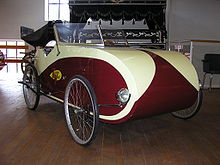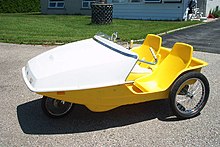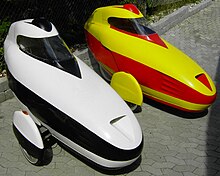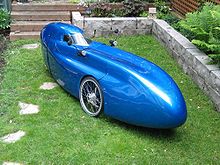Velomobile: Difference between revisions
| Line 63: | Line 63: | ||
* [http://www.velomobileusa.com/ VelomobileUSA (US)] FAW+ (Alleweder A2) |
* [http://www.velomobileusa.com/ VelomobileUSA (US)] FAW+ (Alleweder A2) |
||
* [http://www.weathervelo.com/ WeatherVelo (UK, Germany)] MODE cabin-cycle |
* [http://www.weathervelo.com/ WeatherVelo (UK, Germany)] MODE cabin-cycle |
||
* [http://chn.ge/1gC273p Schwinn (Community based effort to get Velomobiles into mass production in the USA)] |
|||
==DIY velomobiles== |
==DIY velomobiles== |
||
Revision as of 15:32, 26 February 2014
A velomobile, or bicycle car, is a human-powered vehicle (HPV) enclosed for aerodynamic advantage and protection from weather and collisions.[1] Nearly all velomobiles are single-passenger vehicles. They are derived from recumbent bicycles and tricycles, with the addition of a full fairing (aerodynamic shell). Velomobiles generally have three or four wheels, and are therefore not bicycles (which means two wheels); two-wheeled faired bicycles are better known as streamliners. It is streamliners that have set many HPV land records.[2]
There are few manufacturers of velomobiles; some are home-built. Some models have the operator's head exposed; this has the advantage of giving the operator unobstructed vision, hearing, and some cooling, with the disadvantage of being more exposed to weather and less aerodynamic. Similar vehicles that are not human-powered are called microcars. Hybrid vehicles exist which can use both human power and assistance by an electric motor.[3]
History






Before World War I, Charles Mochet built a small four-wheeled 'bike'-car for his son. Mochet built many models of small vehicles called "Velocar". Some models had two seats, most were pedal powered, but as the years went by, many were fitted with small engines.[4]
In the 1970s, the People powered vehicle (PPV) was produced. It was a two-seat, "Sociable" tandem with a steel sub frame and molded plastic body. It was actually well designed and relatively light, though weighing over 50 kg (110 lb) (a recently restored version weighs 59 kg or 130 lb) but had flaws in the execution that doomed it as a practical, everyday vehicle. Positive features, such as easily adjustable and comfortable seats, independent pedalling for both passenger and driver, adequate cargo space and relatively good weather protection, could not overcome the negative features, such as a complex, heavy and badly spaced three-speed gear box, ineffective brakes, and pedals that slid on sleeve bearings on steel shafts, which made it difficult to use as an everyday vehicle.
In Sweden, a design called Fantom was sold as blueprints and became very popular, over 100,000 copies of the blueprints were sold, but few were actually completed. In the 1980s, Fantomen was rediscovered by Carl-Georg Rasmussen, who built a redesigned version called Leitra.[citation needed] The downfall of the 'bicycle' car came when the economy improved and people chose motorised transport.
All current velomobiles are produced in low volume. The only attempt at a mass-produced velomobile, which was in the mid-1980s, flopped. This was the Sinclair C5. The C5 was a delta trike (one front, two rear wheels) with electric assist designed to be mass-produced and sold for a low price. The C5 was poorly designed; it was heavy, had only one gear and had no adjustment for the distance between the pedals and the seat, which is important to get a comfortable pedaling position.
A concept and a potential assessment concerning low-cost velomobiles for daily short trips as well as strategies for reaching a critical lot size for mass production was the subject of a research project called RegInnoMobil.[5]
Velomobiles have also been used in Australian HPV Super Series since 1985.[citation needed]
Fastest Velomobile Models
The fastest, or most efficient, velomobile models currently available on the market (2014) are the Quest from Velomobil.nl (Netherlands), the Milan SL from Räderwerk (Germany), the Go-One Evo Ks from Beyss (Germany) and the WAW from Fietser (Belgium). The Milan was used by Christian von Ascheberg, current record holder in the 24 hours (1219 km) and 1000 km (19h, 27min). While the Quest might not be the fastest model any more it is (due to its longer production span), widely regarded as the most refined and practical fast velomobile model for every day use in the velomobile community.[citation needed]
Electric Assisted Velomobiles
Some velomobiles have been converted to provide electric assist. Electric assist means that a small battery-operated electric-propulsion system is provided to assist the driver's leg muscle effort. Most electric-assist propulsion motors are of the inwheel design in the rear wheel, such as geared hub motors (like eZee, Heinzmann, Bafang, BMC, etc.) and direct-drive hub motors (like Crystalyte, BionX, 9Continent, etc.) but mid-drive units (like Sunstar, Cyclone, Ecospeed, etc.) are used as well due to design constrains in velomobile models with one sided rear wheels mounting like the Quest, Strada and Mango or front wheel drive in the Velayo, or better efficiency by using the multiple speeds of the chain drive or internal geared hubs (e.g. Rohloff 14 speed hub).
While an electric-assist unit does add extra weight to the velomobile,[6] it is somewhat offset by the flexibility it also provides, especially during hill climbs and stop-and-go traffic.[citation needed] Due to vastly better aerodynamics of velomobiles the range of a similar electric assist unit and similar battery in a velomobile can be about 50% to 100% higher compared to upright bicycles or unfaired recumbents.
Manufacturers
The Leitra is currently the velomobile that has been in commercial production for the longest period of time — since 1983. Other manufacturers include:
- Alligt (Netherlands) Alleweder A4, Alleweder A6, Alleweder A9 (Sunrider kit), Sunrider Mk2
- Bike Revolution (Austria) Interceptor, Thunderstorm, Leitra Advancee
- Birkenstock Bicycles (Switzerland)
- bluevelo (Canada) Quest, Quest XS, Strada, Cab-Bike, Team, Hornet
- Cab-Bike (Germany)
- CabrioVelo (Germany)
- Easy Racers (USA)
- Fietser.be WAW (Belgium) beWAW, eWAW
- Flevobike (Netherlands) Orca
- Fortschritt Fahrzeugbau (Germany) Velayo
- Go-One (Germany, USA) Go-One Evo K, Go-One Evo Ks
- Greenspeed (Australia) Greenspeed Glyde (discontinued)
- Leiba (Germany) Classic, X-Stream, X-Sream XXL, Hybrid (S-Pedelec)
- Lightfoot Cycles (USA)
- Oceancycle (UK) Challenger (based on ICE Trikes)
- Organic Transit (USA)[3]
- Ped-3 (Slovenia)
- Räderwerk (Germany) Milan Mk2, Milan SL
- Schöne Linie (Germany)
- Sinner Bikes (Netherlands) Mango
- Sunrider Cycles (Netherlands)
- Trisled (Australia) Aquila, Avatar, Kestrel, Rotovelo
- Velocity Velos (US)
- Veloform (Germany) Velo-Taxi
- Velomobiles.ca Aurora, Borealis (based on ICE Trikes), Milan, Milan SL
- Velomobiel.nl (Netherlands) Quest, Quest XL, Strada
- VelomobileUSA (US) FAW+ (Alleweder A2)
- WeatherVelo (UK, Germany) MODE cabin-cycle
- Schwinn (Community based effort to get Velomobiles into mass production in the USA)
DIY velomobiles
With a growing DIY-community[citation needed] and an increasing interest in environmentally friendly "green energy", some hobbyists have endeavored to build their own velomobiles from kits, sourced components, or from scratch.[7] When compared to similar sized commercial velomobiles, the DIY velomobiles tend to be less expensive.
Probably the most build velomobile kits are the various models of the Alleweder made from prefabricated aluminium sheet metal due to its affortable price. Some velomobile manufacturers offer their models as kits for self-assembly (Räderwerk Milan Mk2 + Milan SL, Beyss Go-One Evo K + Go-One Evo Ks, Alleweder A9/Sunrider Mk2 for instance) at reduced price.
The Borealis (Canada) and Challenger (UK) are velomobile shells made to fit specific tadpole trike models from ICE Trikes (UK) while the Velocity Velos DIY-Kit can be fit to various models of tadpole trikes.
Links: http://wood-velomobile.webnode.nl/links-/
See also
External links
- Bent Rider Online Forums: Velomobiles
- Low Tech Magazine - The Velomobile: High tech bike or low tech car?
- Low Tech Magazine - Electric Velomobiles: as Fast and Comfortable as Automobiles, but 80 times more Efficient
- forum velomobile and bentrider
References
- ^ Frederik Van De Walle. The Velomobile as a Vehicle for more Sustainable Transportation ISSN 1651-0194, Retrieved on 23 November 2007.
- ^ International Human Powered Vehicle Association. Retrieved on Dec 31, 2012
- ^ a b Benjamin Preston (August 5, 2013). "Navigating the Greenway: 1,200-Mile Journey in an Electric Bicycle-Car". The New York Times. Retrieved August 7, 2013.
- ^ The Real History of the Recumbent Bicycle Retrieved on 26 March 2008.
- ^ Research project "RegInnoMobil" about low-cost velomobiles for short daily trips Retrieved on 19 January 2010.
- ^ an electric-assist unit does add extra weight to the velomobile
- ^ Building a velomobile DIY, description with usable designs
